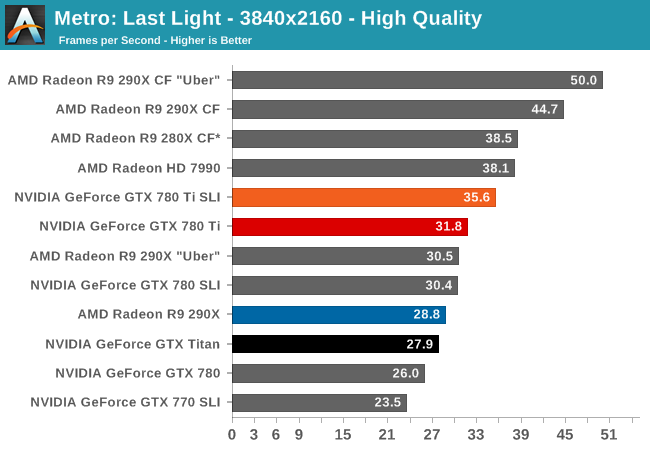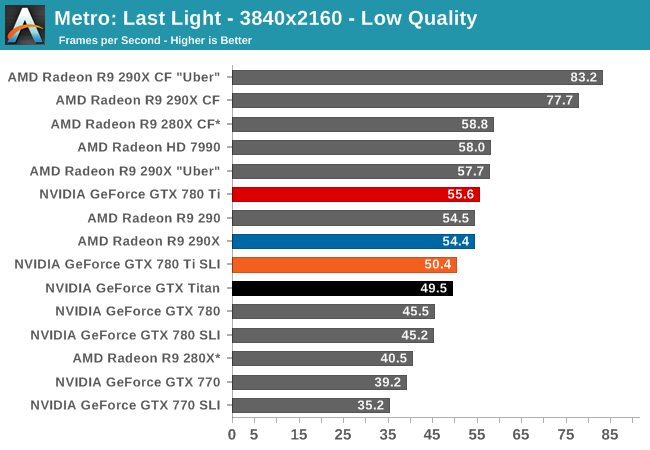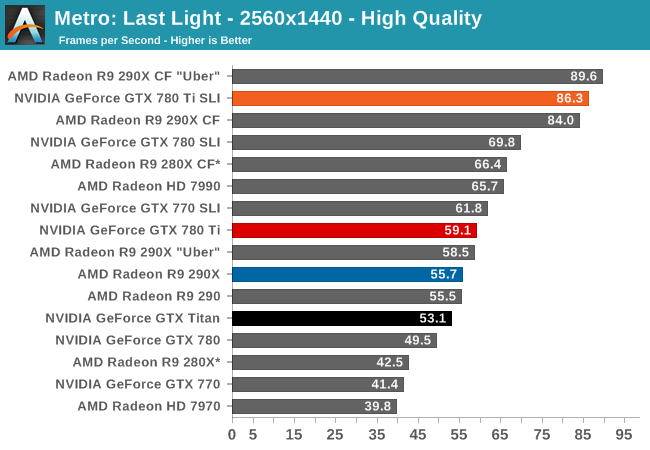The NVIDIA GeForce GTX 780 Ti Review
by Ryan Smith on November 7, 2013 9:01 AM ESTMetro: Last Light
As always, kicking off our look at performance is 4A Games’ latest entry in their Metro series of subterranean shooters, Metro: Last Light. The original Metro: 2033 was a graphically punishing game for its time and Metro: Last Light is in its own right too. On the other hand it scales well with resolution and quality settings, so it’s still playable on lower end hardware.



For the bulk of our analysis we’re going to be focusing on our 2560x1440 results, as monitors at this resolution will be what we expect a single GTX 780 Ti to be primarily used with. A single card does have the necessary horsepower to drive a 4K monitor on its own, but only at lower quality settings. Even as powerful as GTX 780 Ti is, a pair of them will be needed to get good framerates out of most games if using 4K at high quality settings.
Looking at our Metro: Last Light results then, it’s the start of what’s going to be a fairly consistent streak for the GTX 780 Ti. Though it doesn’t improve on GTX Titan or GTX 780’s gaming performance by leaps and bounds, the additional SMX and increased clockspeeds means that it has little trouble pulling away from those cards and from AMD’s 290 series. As a result the GTX 780 Ti beats the GTX Titan by 11%, GTX 780 by 19%, and though it’s closer than normal, the lead over the 290X stands at 6%.
To that end in Metro it leads the pack of single-GPU cards, though it does come up just short of being able to average 60 frames per second at 2560. Anything over 60fps will require multiple GPUs; and even then GTX 780 Ti is fast enough that sometimes even a pair of GPUs (GTX 770 SLI) isn’t going to be appreciably faster.
Meanwhile looking at GTX 780 Ti SLI performance, the SLI setup tops the charts at 2560 for everything short of the 290X in uber mode, though in this case (like most cases) two high-end GPUs is on the verge of being overkill even at 2560. Otherwise looking at 4K, NVIDIA’s poor 4K scaling on Metro once again makes itself present here, with NVIDIA’s performance only minimally benefitting from the second card. In the case of Metro at 4K, the 290X CF is going to be by far the faster option.










302 Comments
View All Comments
polaco - Friday, November 8, 2013 - link
Indeed that's exactly the way I see it. AMD has played it's cards quite well this time. NVidia seems to be on it's price knees and can't compete any way. NVidia needs a new GPU to compete with Hawaii. I don't want to put into cosideration Mantle, TrueAudio, Gsync nor the Shield discount.Mantle and TrueAudio hasn't been demoed yet.
Shield seems like a waste of money and almost useless for me.
Maybe in a future if they prove to be worthy we will see Mantle, TrueAudio and Gsync to be included as part of an upgrade other standards.
Gigaplex - Sunday, November 10, 2013 - link
Only 5% faster than a $1000 card? Yeah, totally overpriced at $700.Sarcasm aside, it really is overpriced. But comparing it to the Titan to justify that claim doesn't work.
polaco - Friday, November 8, 2013 - link
Well looking at Anand's benchmarks I can't find a way to justify spending such amount of money on this card. AMD 290 and 290X looks way more interesting. As difference to others reviews Anand's has focused only in ultra high resolutions I think that's the way to go. Since no one would buy one of this cards (780ti, 290X) to game at 1680x1050. So at this high resolutions performances differences between the cards are barely minimal in most cases and could be reduced even more by drivers updates or settings tunning. I find no reason to spend such a difference for 780 Ti while having more than decent performance from radeon 290 at 250 bucks less. If I would want to go to an extreme instead of aquiring a 780Ti it would be better and get 2xradeon290 for 100 bucks more. So the problem of 780Ti is it's price, pure and simple. I really find difficult NVidia could lower the prices more since it looks 290 and 290X launch has putted NVidia prices to it's knees. So far I'm still waiting for 290, 290X third party coolers if they are good they can even pair or overcome 290 and 290X performance against 780Ti. What I have no doubt is how Titan and 780 early buyers must be feeling at this moment...j6z7 - Friday, November 8, 2013 - link
I think the majority of comments here reveals the truth behind big headlines with reviews.The reference 290X with 10 year old reference cooler still beating the 780ti with best cooler in CF - and it does it being $300 cheaper too!
If anything, Nvidia shot itself in the foot against its own Titan.
Nvidia fans will continue to support the company in ripping people off, while AMD provides same performance at affordable prices.
End of the day, people who'll buy the 290X will be much more satisfied customers.
The End.
Mondozai - Friday, December 13, 2013 - link
Nvidia fanboys like EJS1980 are like battered wives. They are trying to rationalize themselves being raped.b3nzint - Friday, November 8, 2013 - link
You must be pissed with 290x being priced that low. Anyway AMD should reconsider for using that blower type fan. Nvidia have better cooling system than AMD, but for that price i just don't care. For $700? still too much.b3nzint - Friday, November 8, 2013 - link
what about mantle, compute power and trueaudio? u don't buy gpu for just friggin fps number!wwwcd - Friday, November 8, 2013 - link
WoW Ryan cut my comment. I know he is a really hard green fen, but this censor not placed with democracy. I can revenge of m-r Anand!Ryan Smith - Friday, November 8, 2013 - link
Uh, we haven't deleted anything. Are you sure you haven't just misplaced your comment?not_there - Friday, November 8, 2013 - link
I'm not a gamer, but I like to put a decent video card in my builds to run Folding@Home. It's real science and it helps heat my basement. Reading the reviews here I'm confused (someone point out what I'm missing). In a June review of the GTX 760 the Radeon HD 7970 got a 36.1 and in this review, the same card on the same test got a 29.3. This was the Folding@Home Explicit, Single Precision benchmark. June number for the GTX 770 in this test was 35.6 and in the same test on the same card in this review the benchmark is 15.1. Why the difference?